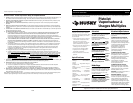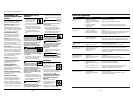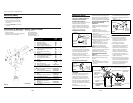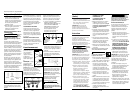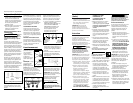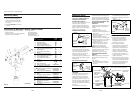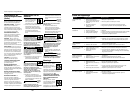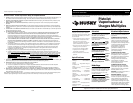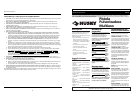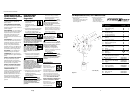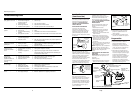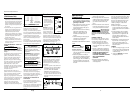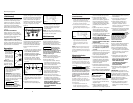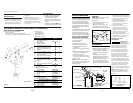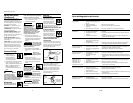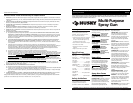
23 Sp
Guía de Diagnóstico de Averías
Problema Posible(s) Causa(s) Acción a Tomar
El patrón de rocío es
muy pequeño
El patrón de rocío es
inadecuado
Exceso de rocío
Fuga por la tuerca de
control de fluído
Fuga por el envase y la
tapa del envase
Cáscara de naranja
(apariencia de
ondulación áspera
semejante a una
cáscara de naranja real)
Chorreos y depresiones
Superficie con acabado
moteado y tosco
1. Acumulación de material
seco en los orificios de la tapa
de aire
2. Material aglutinado
3. Insuficiente cantidad de
material
4. Insuficiente presión de fluído
1. El material está muy espeso
2. La tapa de aire está sucia
3. Está aplicando mucho
material
4. El patrón es muy ancho
1. Demasiada presión de aire
para el tipo de material que
está aplicando
2. El material está muy diluído
1. El empaque está muy flojo
2. El empaque está desgastado
o reseco
1. El empaque del envase está
mal colocado
2. El envase no está bien
apretado
1. El material se está secando
muy rápido
2. Pistola muy lejos de la superficie
3. Material muy espeso
1. Material muy diluido
2. La pistola se está moviendo
muy lentamente
3. Flujo excesivo de material
4. Pistola muy cerca de la superficie
1. Demasiado solvente
2. Técnica deficiente de rociado
1. Limpie la tapa de aire
2. Diluya o cuele el material
3. Abra más la perilla de control de fluído
4. Aumente la presión de aire. No exceda 3,45 bar
1. Diluya el material
2. Límpiela
3. Cierre la perilla de control de fluído para reducir el flujo de
material
4. Cierre más la perilla de control de fluído o acerque más la
pistola a la pieza de trabajo
1. Reduzca la presión de aire
2. Mézclelo con material más espeso. Reduzca la presión de
aire. Gradualmente abra la perilla de control de fluído
1. Apriete la tuerca del empaque. Reemplace el empaque si no
puede parar la fuga al apretar la tuerca
2. Reemplácela o lubríquela con aceite sinsilicón
1. Limpie el empaque. Reeplácelo si es necesario
2. Apriételo bien. Aplique una pequeña cantidad de vaselina o
grasa mineral en las roscas cuando vaya a colocarle la tapa al
envase
1. Use un solvente más lento o añanda un agente retardante
2. Acerque la pistola a la superficie
3. Diluya el material según las instrucciones de cómo hacer
menos densos los materiales
1. Añada material para aumentar el espesor
2. Mueva la pistola más rápido
3. Gire la perilla de control de material en sentido horario para
reducir el flujo
4. Aleje más la pistola de la superficie
1. Disminuya el solvente
2. Refiérase a “Operación” para las instrucciones de rociado
Set Up
USE OF AIR CAPS
Internal Mix—Generally
used with slow drying,
heavy bodied materials
and for faster material
application. NOT to be used with fast
drying paints and lacquers which will
clog the opening in the air cap.
INTERNAL MIX CAPS MUST BE USED
WITH PRESSURE FEED operation.
External Mix—Used for
quick drying, light bodied
materials such as lacquers
and synthetic enamels.
Better for finer finish work. THESE
CAPS CAN BE USED WITH EITHER
SIPHON OR PRESSURE FEED.
FAN DIRECTION
The direction of the fan (horizontal or
vertical) can be changed by loosening
the lock ring and turning the air cap 90
degrees (See Figure 1). Hand tighten
lock ring after adjustment.
FLUID FEED
This model is capable of pressure or
siphon feed. Standard set-up is
pressure feed mode; change to siphon
mode for a finer finish using light
materials. To change modes, remove
setscrew from the canister top and
place in the lower part of the gun
head (See Figure 2).
Spray Gun Terms
(Continued)
type of operation is used with a
compressor equipped with a tank or
with a large factory air system. Do not
use with a continuous run compressor
that does not have a tank.
VISCOSITY – A measurement of the
resistance of the flow of a liquid.
ATOMIZATION - Conversion of liquid
to spray droplets (mist).
PATTERN CONTROL KNOB – Used to
form the proper pattern (size and
shape) of material as it is sprayed from
the gun to the work piece.
FLUID CONTROL KNOB – Used to
control the amount of material being
mixed with air.
PAINT TANK – An auxiliary pressurized
paint reservoir that allows continuous
spraying of large amounts of paint
without stopping for refills as with a
canister. It also allows using the spray
gun at any angle or orientation.
General Safety
1. Read all manuals
included with this
product carefully. Be
thoroughly familiar
with the controls and the proper
use of the equipment.
2. Follow all local electrical and safety
codes as well as in the United
States, the National Electrical Codes
(NEC), Occupational Safety and
Health Act (OSHA) and the
Environmental Protection Agency
(EPA).
Use a face mask/respirator
and protective clothing
when spraying. Always
spray in a well ventilated
area to prevent health and fire hazards.
Refer to Material Safety Data Sheets
(MSDS) of spray material for details.
Never spray closer than 25
feet to the compressor! If
!
DANGER
!
WARNING
2
Multi-Purpose Spray Gun
possible, locate compressor in separate
room. Never spray into the compressor,
compressor controls or the motor.
3. Do not smoke or eat when spraying
paint, insecticides, or other
flammable substances.
Do not spray flammable
materials in vicinity of
open flame or near
ignition sources. Motors, electrical
equipment and controls can cause
electrical arcs that will ignite a
flammable gas or vapor. Never store
flammable liquids or gases in the
vicinity of the compressor.
4. When spraying and cleaning,
always follow the instructions and
safety precautions provided by the
material manufacturer (Refer to
MSDS).
Do not spray acids,
corrosive materials,
toxic chemicals, fertilizers or pesticides.
Using these materials could result in
death or serious injury.
5. Keep visitors away and NEVER
allow children or pets in the work
area.
Never aim or
spray at yourself
or anyone else or serious injury could
occur.
6. Always work in a clean
environment. To avoid injury and
damage to the workpiece, do not
aim the spray gun at any dust or
debris.
Do not use pressure that
exceeds the operating
pressure of any of the
parts (hoses, fittings, etc.) in the
painting system.
Keep hose away
from sharp objects.
Bursting air hoses may cause injury.
Examine air hoses regularly and replace
if damaged.
7. Always use a pressure regulator on
the air supply to the spray gun.
Failure to install
appropriate
water/oil removal equipment may
result in damage to machinery or
workpiece.
NOTICE
!
CAUTION
!
WARNING
!
WARNING
!
WARNING
!
WARNING
MANUAL
Figure 1
Horizontal Fan
Vertical Fan
Air Cap
Lock Ring
Place
setscrew
in lower
hole
Remove from
underside of
canister top
Figure 2



